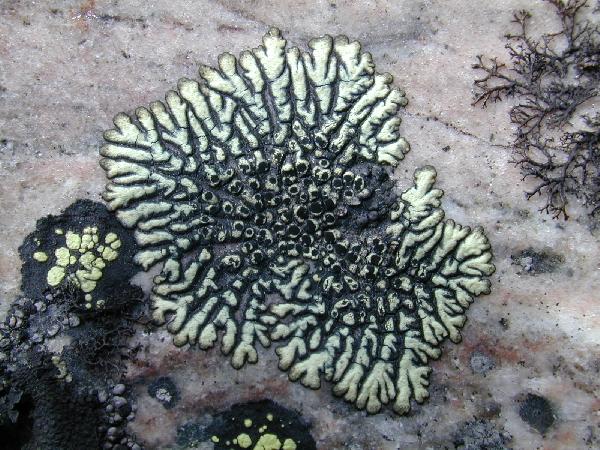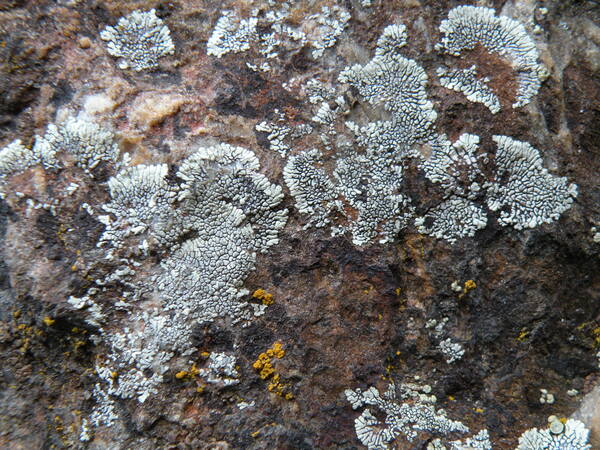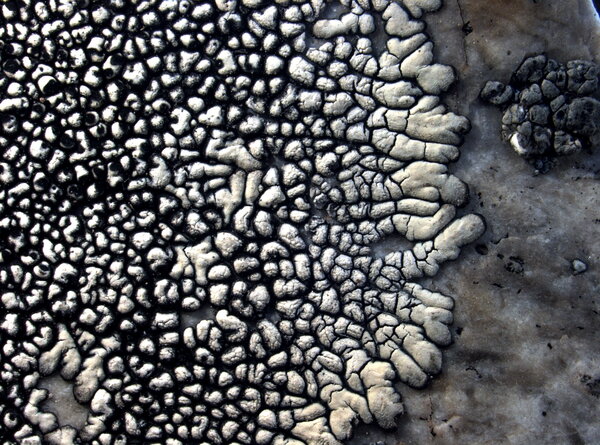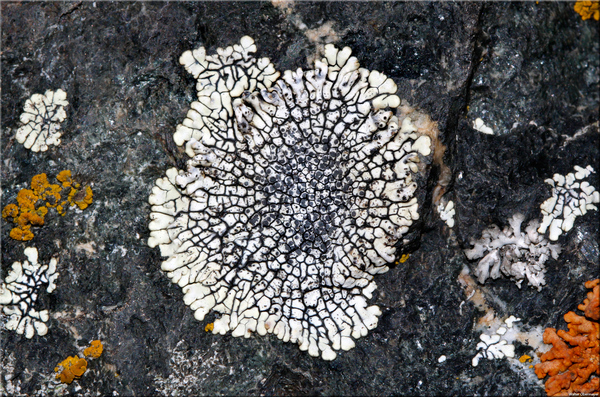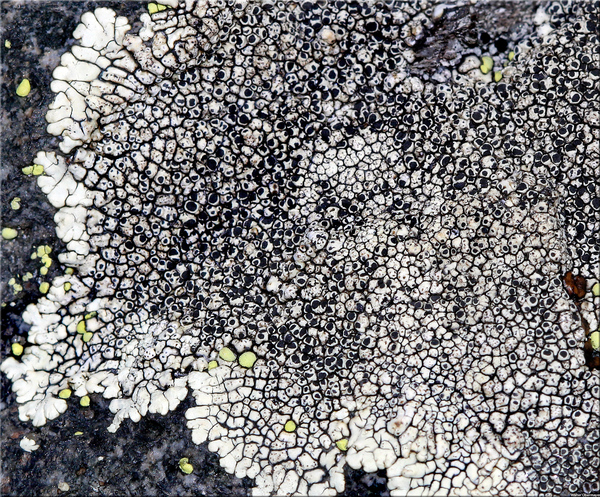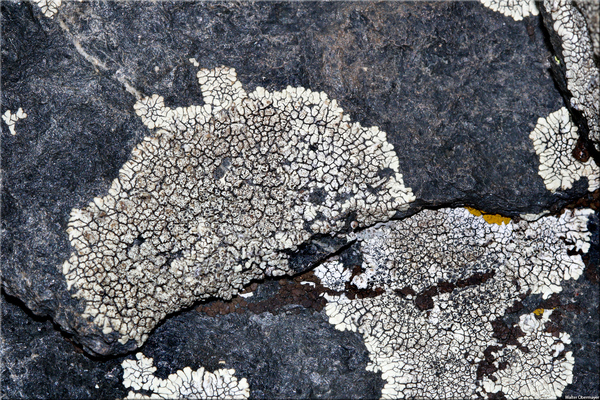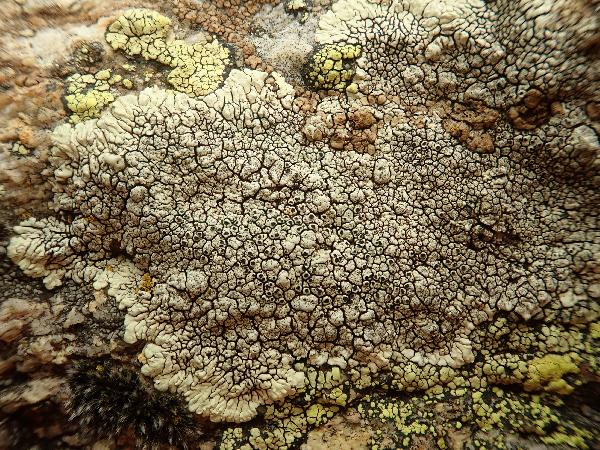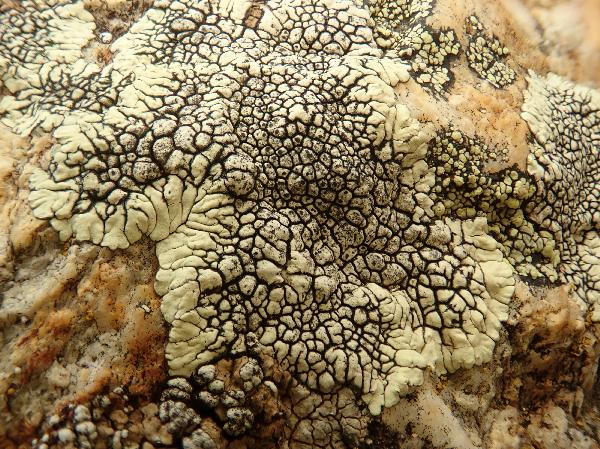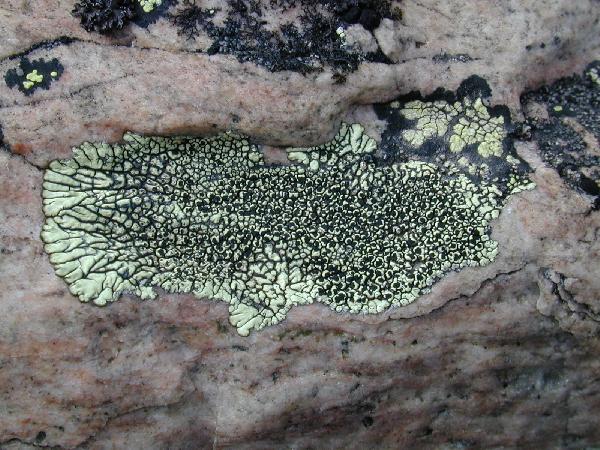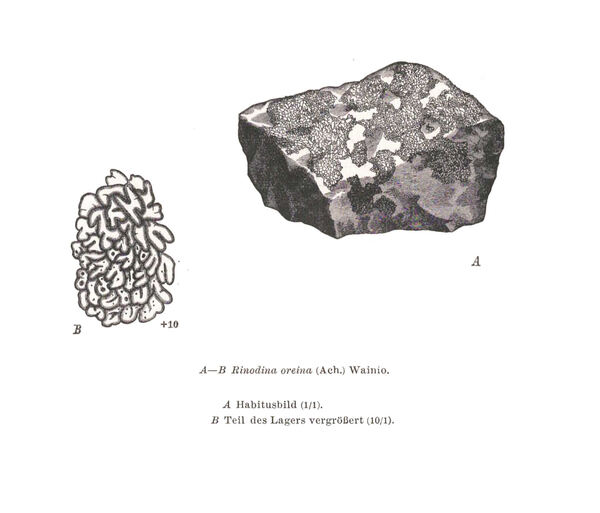Dimelaena oreina (Ach.) Norman
Nytt Mag. Naturvid., 7: 231, 1852. Basionym: Lecanora straminea Ach. var. oreina Ach. - Lichenogr. Univ.: 433, 1810.
Synonyms: Beltraminia oreina (Ach.) Trevis.; Dimelaena griseoviridis (H. Magn.) Vězda; Lecanora mougeotioides Nyl.; Lecanora oreina (Ach.) Ach.; Rinodina mougeotioides (Nyl.) Mong.; Rinodina oreina (Ach.) A. Massal.; Rinodina oreina var. mougeotioides (Nyl.) Zahlbr.
Distribution: N - Frl, Ven, TAA (Rambold & al. 1994, Obermayer 2003, Nascimbene 2008b, Nascimbene & al. 2022), Lomb (Dalle Vedove & al. 2004, Brackel 2013), Piem (Morisi & Sereno 1995, Allisiardi 2001, Isocrono & al. 2003, 2004, Isocrono & Piervittori 2008), VA (Borlandelli & al. 1996, Piervittori & Isocrono 1997, 1999, Piervittori & al. 1998, 2001, 2004, Isocrono & al. 2008, Favero-Longo & Piervittori 2009, Matteucci & al. 2015c), Lig (UPS-L-524279). C - Abr, Sar. S - Si (Nimis & al. 1996b).
Description: Thallus crustose-placodioid, episubstratic, greenish yellow to yellowish grey, areolate in central parts, forming regular to irregular rosettes, the individual thalli often merging to cover large surfaces. Areoles 0.3-1 mm wide, slightly convex, developing on a dark hypothallus; lobes to 1.5 mm wide and 2 mm long, mostly flat. Upper phenocortex pseudoparenchymatous, often with crystal inclusions; medulla white, of loosely interwoven hyphae, I+ blue. Apothecia frequent, 1(-3) per areole, at first cryptolecanorine and immersed in the thallus then lecanorine and more or less adnate, 0.2-1(-1.5) mm across, with a black, sometimes white-pruinose, flat to slightly convex disc and a thin thalline margin. Epithecium brown; hymenium colourless, inspersed with oil droplets, 80-100 µm high, I+ blue; paraphyses simple or weakly branched, 2-3 µm thick at base, the apical cells 3-6 µm wide; hypothecium colourless, 80-125 µm high. Asci 8-spored, cylindrical-clavate, the apical dome K/I+ dark blue with a pale, conical-pointed apical cushion (axial mass), the wall I-, but the thin outer gel I+ blue, Bacidia-type. Ascospores 1-septate, markedly constricted in the middle, grey to brown, broadly ellipsoid, 8.5-13(-15) x 4.5-8 µm, with a distinct torus around the septum, the wall unthickened, Beltraminia-type. Pycnidia immersed in the areoles, pyriform. Conidia hyaline, simple, bacilliform, 3-6 x 0.7-1 µm. Photobiont chlorococcoid. Spot tests: K+ yellow, C-, KC-, P+ red (chemotype I), K-, C+ red, P- (chemotype II), K-, C-, KC-, P- (chemotype III, VI), K+ yellow, C+ red, P+ red (chemotype IV), K+ yellow, C-, KC-, P+ orange (chemotype V), K+ yellow, C+ red, P+ orange (chemotype VII). Chemistry: major compounds are usnic acid, fumarprotocetraric acid (chemotype I), usnic acid, gyrophoric acid (chemotype II), usnic acid alone (chemotype III), usnic acid, gyrophoric acid, fumarprotocetraric acid (chemotype IV), usnic acid, stictic acid (chemotype V), usnic acid, hypostictic acid (major) stictic acid (Chemotype Vb), usnic acid, sphaerophorin (VI), usnic acid, gyrophoric acid, stictic acid (chemotype VII); norstictic, lecanoric and ovoic acids may be present as minor compounds. Chemotype V is the most frequent in Italy, chemotype VI is not known from Europe.Note: a widespread, holarctic species found on hard siliceous rocks, incl. quartz, in sunny-dry situations, often on steeply inclined faces, common only in dry-continental areas, from some parts of the Mediterranean coast to dry Alpine valleys; the species is chemically variable (see e.g. Obermayer & al. 2004, Rico & al. 2006), and a chemical study of Italian populations is still wanting.
Growth form: Crustose
Substrata: rocks
Photobiont: green algae other than Trentepohlia
Reproductive strategy: mainly sexual
Subcontinental: restricted to areas with a dry-subcontinental climate (e.g. dry Alpine valleys, parts of Mediterranean Italy)
Commonnes-rarity: (info)
Alpine belt: rather common
Subalpine belt: common
Oromediterranean belt: very rare
Montane belt: rather rare
Submediterranean belt: very rare
Padanian area: absent
Humid submediterranean belt: absent
Humid mediterranean belt: absent
Dry mediterranean belt: extremely rare
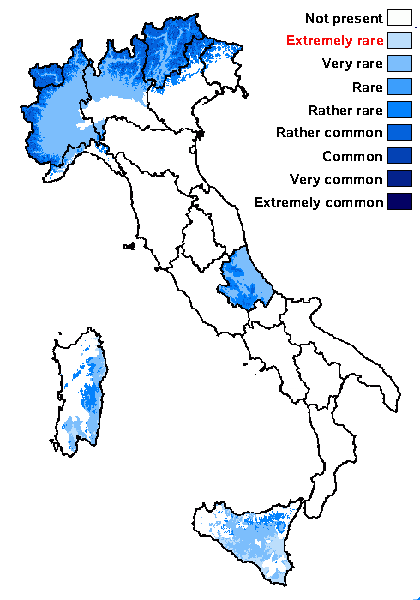
Predictive model
Herbarium samples
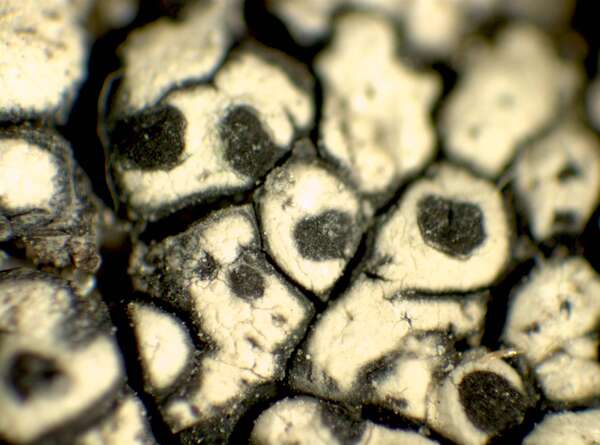

P.L. Nimis; Owner: Department of Life Sciences, University of Trieste
Herbarium: TSB (32846)
2001/12/08
apothecia


Felix Schumm – CC BY-SA 4.0
[2866], Spanien, Kanarische Inseln, Tenerife, flächendeckend an trockengetönten, lichtoffenen und windgefegten Stirnflächen feinkörnigen Ergußgesteins, 2200-2300 m, NO-NW, pH 6,9, Nordabfall der Montaña de Guajara im südlichen Cañadaszirkel. Leg. et det. G. Follmann 03.1980. Ex Follmann Lichenes Exs. 330
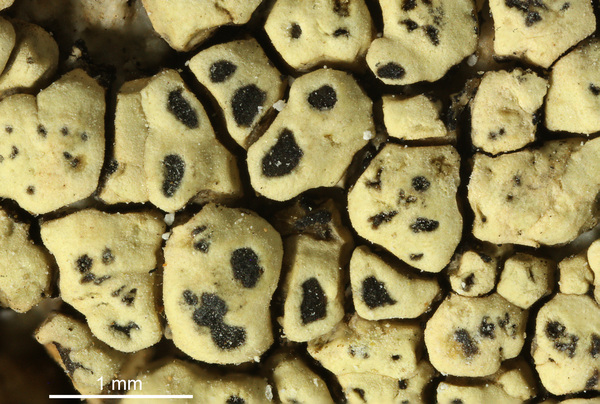

Felix Schumm – CC BY-SA 4.0
[2866], Spanien, Kanarische Inseln, Tenerife, flächendeckend an trockengetönten, lichtoffenen und windgefegten Stirnflächen feinkörnigen Ergußgesteins, 2200-2300 m, NO-NW, pH 6,9, Nordabfall der Montaña de Guajara im südlichen Cañadaszirkel. Leg. et det. G. Follmann 03.1980. Ex Follmann Lichenes Exs. 330


Felix Schumm – CC BY-SA 4.0
[2866], Spanien, Kanarische Inseln, Tenerife, flächendeckend an trockengetönten, lichtoffenen und windgefegten Stirnflächen feinkörnigen Ergußgesteins, 2200-2300 m, NO-NW, pH 6,9, Nordabfall der Montaña de Guajara im südlichen Cañadaszirkel. Leg. et det. G. Follmann 03.1980. Ex Follmann Lichenes Exs. 330
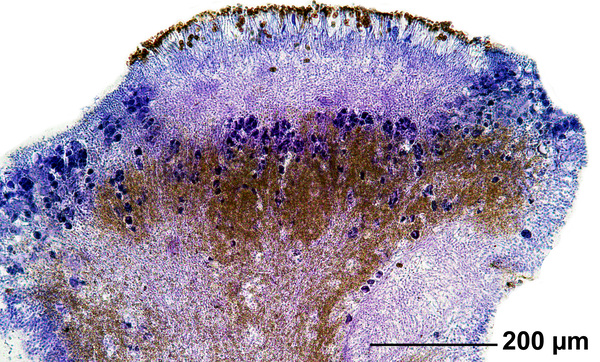

Felix Schumm – CC BY-SA 4.0
[2866], Spanien, Kanarische Inseln, Tenerife, flächendeckend an trockengetönten, lichtoffenen und windgefegten Stirnflächen feinkörnigen Ergußgesteins, 2200-2300 m, NO-NW, pH 6,9, Nordabfall der Montaña de Guajara im südlichen Cañadaszirkel. Leg. et det. G. Follmann 03.1980. Ex Follmann Lichenes Exs. 330


Felix Schumm – CC BY-SA 4.0
[2866], Spanien, Kanarische Inseln, Tenerife, flächendeckend an trockengetönten, lichtoffenen und windgefegten Stirnflächen feinkörnigen Ergußgesteins, 2200-2300 m, NO-NW, pH 6,9, Nordabfall der Montaña de Guajara im südlichen Cañadaszirkel. Leg. et det. G. Follmann 03.1980. Ex Follmann Lichenes Exs. 330


Felix Schumm – CC BY-SA 4.0
[2866], Spanien, Kanarische Inseln, Tenerife, flächendeckend an trockengetönten, lichtoffenen und windgefegten Stirnflächen feinkörnigen Ergußgesteins, 2200-2300 m, NO-NW, pH 6,9, Nordabfall der Montaña de Guajara im südlichen Cañadaszirkel. Leg. et det. G. Follmann 03.1980. Ex Follmann Lichenes Exs. 330
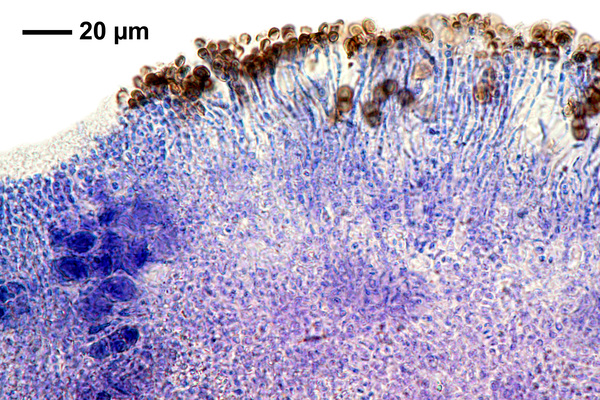

Felix Schumm – CC BY-SA 4.0
[2866], Spanien, Kanarische Inseln, Tenerife, flächendeckend an trockengetönten, lichtoffenen und windgefegten Stirnflächen feinkörnigen Ergußgesteins, 2200-2300 m, NO-NW, pH 6,9, Nordabfall der Montaña de Guajara im südlichen Cañadaszirkel. Leg. et det. G. Follmann 03.1980. Ex Follmann Lichenes Exs. 330
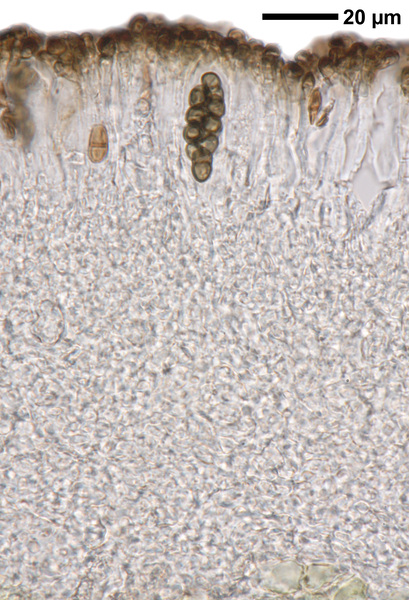

Felix Schumm – CC BY-SA 4.0
[2866], Spanien, Kanarische Inseln, Tenerife, flächendeckend an trockengetönten, lichtoffenen und windgefegten Stirnflächen feinkörnigen Ergußgesteins, 2200-2300 m, NO-NW, pH 6,9, Nordabfall der Montaña de Guajara im südlichen Cañadaszirkel. Leg. et det. G. Follmann 03.1980. Ex Follmann Lichenes Exs. 330


Felix Schumm – CC BY-SA 4.0
[2866], Spanien, Kanarische Inseln, Tenerife, flächendeckend an trockengetönten, lichtoffenen und windgefegten Stirnflächen feinkörnigen Ergußgesteins, 2200-2300 m, NO-NW, pH 6,9, Nordabfall der Montaña de Guajara im südlichen Cañadaszirkel. Leg. et det. G. Follmann 03.1980. Ex Follmann Lichenes Exs. 330
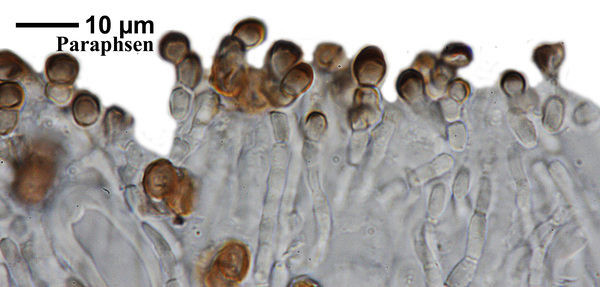

Felix Schumm – CC BY-SA 4.0
[2866], Spanien, Kanarische Inseln, Tenerife, flächendeckend an trockengetönten, lichtoffenen und windgefegten Stirnflächen feinkörnigen Ergußgesteins, 2200-2300 m, NO-NW, pH 6,9, Nordabfall der Montaña de Guajara im südlichen Cañadaszirkel. Leg. et det. G. Follmann 03.1980. Ex Follmann Lichenes Exs. 330
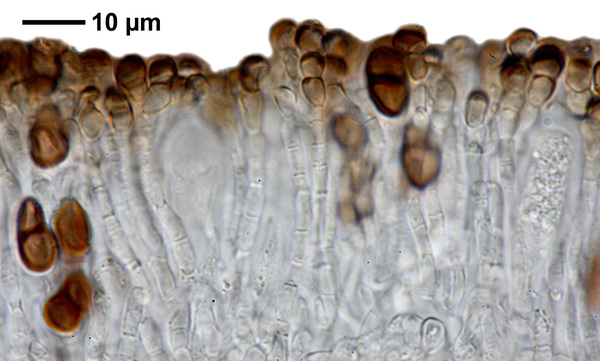

Felix Schumm – CC BY-SA 4.0
[2866], Spanien, Kanarische Inseln, Tenerife, flächendeckend an trockengetönten, lichtoffenen und windgefegten Stirnflächen feinkörnigen Ergußgesteins, 2200-2300 m, NO-NW, pH 6,9, Nordabfall der Montaña de Guajara im südlichen Cañadaszirkel. Leg. et det. G. Follmann 03.1980. Ex Follmann Lichenes Exs. 330
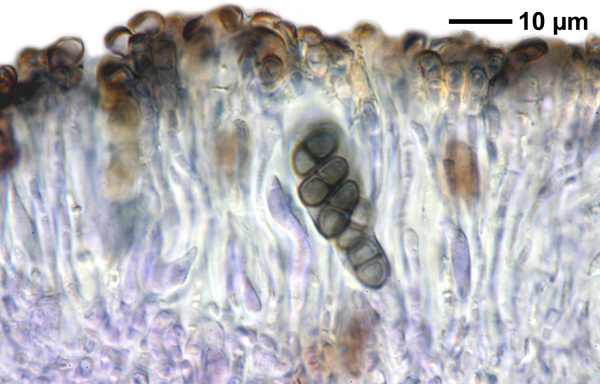

Felix Schumm – CC BY-SA 4.0
[2866], Spanien, Kanarische Inseln, Tenerife, flächendeckend an trockengetönten, lichtoffenen und windgefegten Stirnflächen feinkörnigen Ergußgesteins, 2200-2300 m, NO-NW, pH 6,9, Nordabfall der Montaña de Guajara im südlichen Cañadaszirkel. Leg. et det. G. Follmann 03.1980. Ex Follmann Lichenes Exs. 330
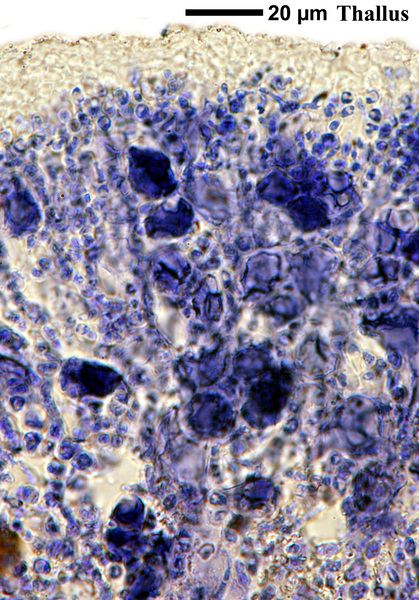

Felix Schumm – CC BY-SA 4.0
[2866], Spanien, Kanarische Inseln, Tenerife, flächendeckend an trockengetönten, lichtoffenen und windgefegten Stirnflächen feinkörnigen Ergußgesteins, 2200-2300 m, NO-NW, pH 6,9, Nordabfall der Montaña de Guajara im südlichen Cañadaszirkel. Leg. et det. G. Follmann 03.1980. Ex Follmann Lichenes Exs. 330
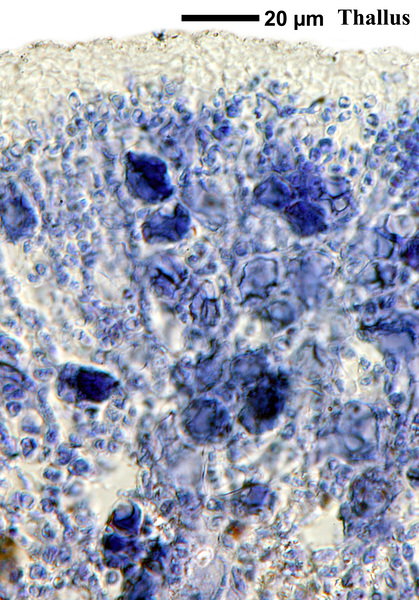

Felix Schumm – CC BY-SA 4.0
[2866], Spanien, Kanarische Inseln, Tenerife, flächendeckend an trockengetönten, lichtoffenen und windgefegten Stirnflächen feinkörnigen Ergußgesteins, 2200-2300 m, NO-NW, pH 6,9, Nordabfall der Montaña de Guajara im südlichen Cañadaszirkel. Leg. et det. G. Follmann 03.1980. Ex Follmann Lichenes Exs. 330
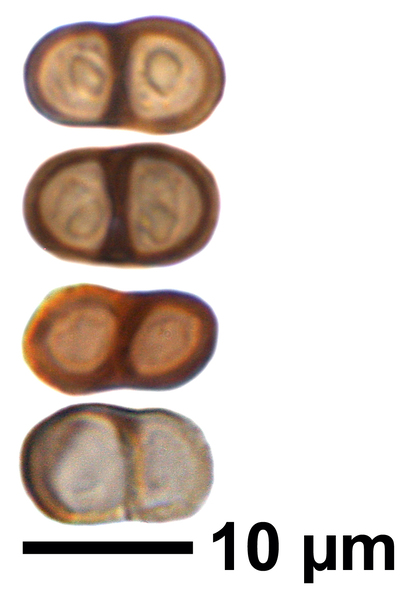

Felix Schumm – CC BY-SA 4.0
[2866], Spanien, Kanarische Inseln, Tenerife, flächendeckend an trockengetönten, lichtoffenen und windgefegten Stirnflächen feinkörnigen Ergußgesteins, 2200-2300 m, NO-NW, pH 6,9, Nordabfall der Montaña de Guajara im südlichen Cañadaszirkel. Leg. et det. G. Follmann 03.1980. Ex Follmann Lichenes Exs. 330


Felix Schumm – CC BY-SA 4.0
[2866], Spanien, Kanarische Inseln, Tenerife, flächendeckend an trockengetönten, lichtoffenen und windgefegten Stirnflächen feinkörnigen Ergußgesteins, 2200-2300 m, NO-NW, pH 6,9, Nordabfall der Montaña de Guajara im südlichen Cañadaszirkel. Leg. et det. G. Follmann 03.1980. Ex Follmann Lichenes Exs. 330
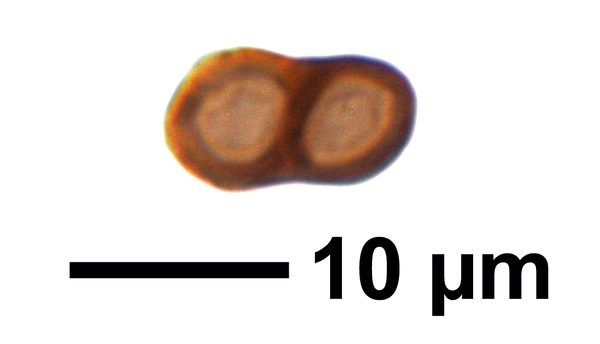

Felix Schumm – CC BY-SA 4.0
[2866], Spanien, Kanarische Inseln, Tenerife, flächendeckend an trockengetönten, lichtoffenen und windgefegten Stirnflächen feinkörnigen Ergußgesteins, 2200-2300 m, NO-NW, pH 6,9, Nordabfall der Montaña de Guajara im südlichen Cañadaszirkel. Leg. et det. G. Follmann 03.1980. Ex Follmann Lichenes Exs. 330
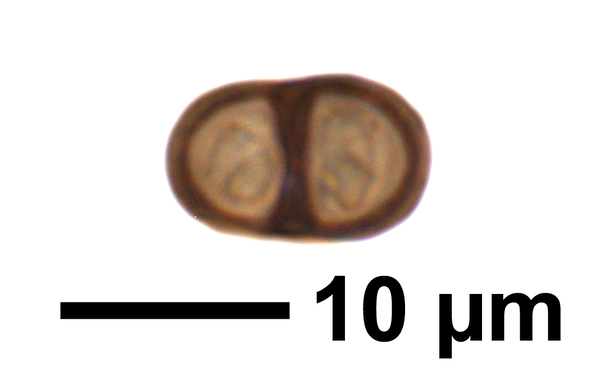

Felix Schumm – CC BY-SA 4.0
[2866], Spanien, Kanarische Inseln, Tenerife, flächendeckend an trockengetönten, lichtoffenen und windgefegten Stirnflächen feinkörnigen Ergußgesteins, 2200-2300 m, NO-NW, pH 6,9, Nordabfall der Montaña de Guajara im südlichen Cañadaszirkel. Leg. et det. G. Follmann 03.1980. Ex Follmann Lichenes Exs. 330


Felix Schumm – CC BY-SA 4.0
[2866], Spanien, Kanarische Inseln, Tenerife, flächendeckend an trockengetönten, lichtoffenen und windgefegten Stirnflächen feinkörnigen Ergußgesteins, 2200-2300 m, NO-NW, pH 6,9, Nordabfall der Montaña de Guajara im südlichen Cañadaszirkel. Leg. et det. G. Follmann 03.1980. Ex Follmann Lichenes Exs. 330


Felix Schumm – CC BY-SA 4.0
[2866], Spanien, Kanarische Inseln, Tenerife, flächendeckend an trockengetönten, lichtoffenen und windgefegten Stirnflächen feinkörnigen Ergußgesteins, 2200-2300 m, NO-NW, pH 6,9, Nordabfall der Montaña de Guajara im südlichen Cañadaszirkel. Leg. et det. G. Follmann 03.1980. Ex Follmann Lichenes Exs. 330
HPTLC in den Laufmitteln A, B’ und C nach Säurebehandlung bei
Tageslicht und 366 nm UV-Langwelle.
1: Start,
4: Position von Norstictinsäure,
7: Position von Atranorin,
us: Usninsäure
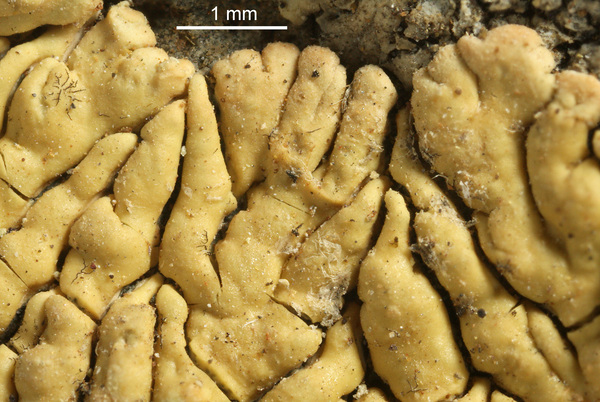

Felix Schumm – CC BY-SA 4.0
[8663], Portugal, Madeira, bei Portinho Flores zwischen Gaula und Canico de Baixo, 32°39.108’ N, 16°49.056’ W, 45 m, trockene, sonnige, küstennahe Lavafelsen. Leg. Schumm 16.04.2001, det. Aptroot 2010.


Felix Schumm – CC BY-SA 4.0
[8663], Portugal, Madeira, bei Portinho Flores zwischen Gaula und Canico de Baixo, 32°39.108’ N, 16°49.056’ W, 45 m, trockene, sonnige, küstennahe Lavafelsen. Leg. Schumm 16.04.2001, det. Aptroot 2010.
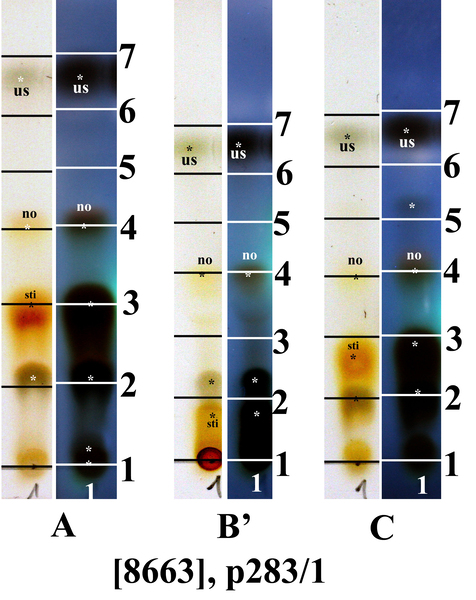

Felix Schumm – CC BY-SA 4.0
[8663], Portugal, Madeira, bei Portinho Flores zwischen Gaula und Canico de Baixo, 32°39.108’ N, 16°49.056’ W, 45 m, trockene, sonnige, küstennahe Lavafelsen. Leg. Schumm 16.04.2001, det. Aptroot 2010.
HPTLC in den Laufmitteln A, B’ und C nach Säurebehandlung beiTageslicht und 366 nm UV-Langwelle.1: Start,4: Position von Norstictinsäure,7: Position von Atranorin,us: Usninsäure, sti: Stictinsäure, no: Norstictinsäure
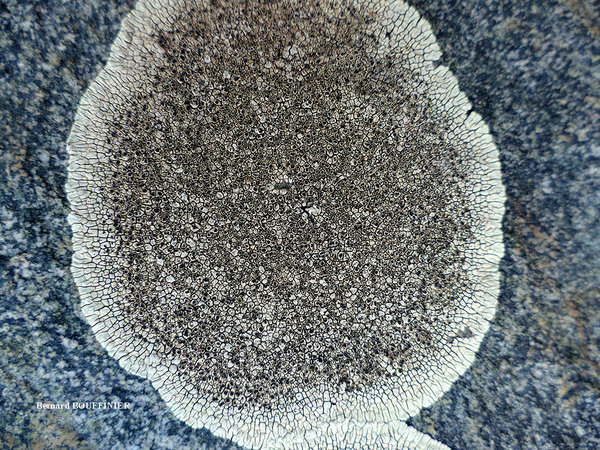
Bernard Bouffinier - Source: http://www.lichensmaritimes.org/index.php?task=fiche&lichen=905&lang=en
France, Corse, Murato
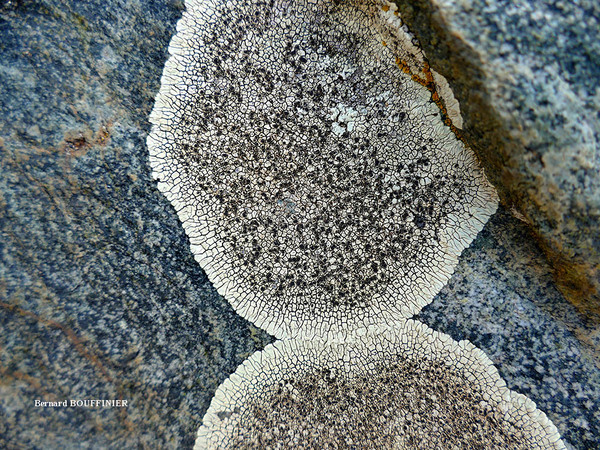
Bernard Bouffinier - Source: http://www.lichensmaritimes.org/index.php?task=fiche&lichen=905&lang=en
France, Corse, Murato
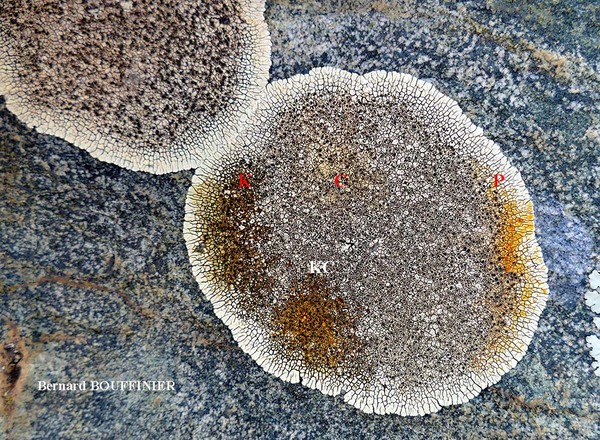
Bernard Bouffinier - Source: http://www.lichensmaritimes.org/index.php?task=fiche&lichen=905&lang=en
France, Corse, Murato
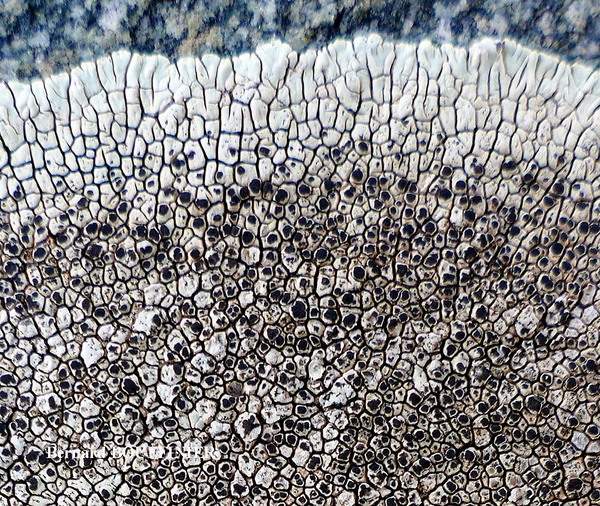
Bernard Bouffinier - Source: http://www.lichensmaritimes.org/index.php?task=fiche&lichen=905&lang=en
France, Corse, Murato
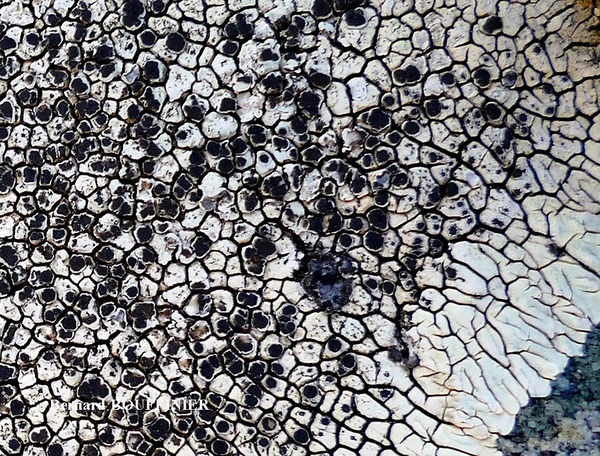
Bernard Bouffinier - Source: http://www.lichensmaritimes.org/index.php?task=fiche&lichen=905&lang=en
France, Corse, Murato

Ulrich Kirschbaum CC BY-SA 4.0 - Source: https://www.thm.de/lse/ulrich-kirschbaum/flechtenbilder
Austria: Alps
Growth form: Crustose
Substrata: rocks
Photobiont: green algae other than Trentepohlia
Reproductive strategy: mainly sexual
Subcontinental: restricted to areas with a dry-subcontinental climate (e.g. dry Alpine valleys, parts of Mediterranean Italy)
Commonnes-rarity: (info)
Alpine belt: rather common
Subalpine belt: common
Oromediterranean belt: very rare
Montane belt: rather rare
Submediterranean belt: very rare
Padanian area: absent
Humid submediterranean belt: absent
Humid mediterranean belt: absent
Dry mediterranean belt: extremely rare

Predictive model
| Herbarium samples |


P.L. Nimis; Owner: Department of Life Sciences, University of Trieste
Herbarium: TSB (32846)
2001/12/08
apothecia


Felix Schumm – CC BY-SA 4.0
[2866], Spanien, Kanarische Inseln, Tenerife, flächendeckend an trockengetönten, lichtoffenen und windgefegten Stirnflächen feinkörnigen Ergußgesteins, 2200-2300 m, NO-NW, pH 6,9, Nordabfall der Montaña de Guajara im südlichen Cañadaszirkel. Leg. et det. G. Follmann 03.1980. Ex Follmann Lichenes Exs. 330


Felix Schumm – CC BY-SA 4.0
[2866], Spanien, Kanarische Inseln, Tenerife, flächendeckend an trockengetönten, lichtoffenen und windgefegten Stirnflächen feinkörnigen Ergußgesteins, 2200-2300 m, NO-NW, pH 6,9, Nordabfall der Montaña de Guajara im südlichen Cañadaszirkel. Leg. et det. G. Follmann 03.1980. Ex Follmann Lichenes Exs. 330


Felix Schumm – CC BY-SA 4.0
[2866], Spanien, Kanarische Inseln, Tenerife, flächendeckend an trockengetönten, lichtoffenen und windgefegten Stirnflächen feinkörnigen Ergußgesteins, 2200-2300 m, NO-NW, pH 6,9, Nordabfall der Montaña de Guajara im südlichen Cañadaszirkel. Leg. et det. G. Follmann 03.1980. Ex Follmann Lichenes Exs. 330


Felix Schumm – CC BY-SA 4.0
[2866], Spanien, Kanarische Inseln, Tenerife, flächendeckend an trockengetönten, lichtoffenen und windgefegten Stirnflächen feinkörnigen Ergußgesteins, 2200-2300 m, NO-NW, pH 6,9, Nordabfall der Montaña de Guajara im südlichen Cañadaszirkel. Leg. et det. G. Follmann 03.1980. Ex Follmann Lichenes Exs. 330


Felix Schumm – CC BY-SA 4.0
[2866], Spanien, Kanarische Inseln, Tenerife, flächendeckend an trockengetönten, lichtoffenen und windgefegten Stirnflächen feinkörnigen Ergußgesteins, 2200-2300 m, NO-NW, pH 6,9, Nordabfall der Montaña de Guajara im südlichen Cañadaszirkel. Leg. et det. G. Follmann 03.1980. Ex Follmann Lichenes Exs. 330


Felix Schumm – CC BY-SA 4.0
[2866], Spanien, Kanarische Inseln, Tenerife, flächendeckend an trockengetönten, lichtoffenen und windgefegten Stirnflächen feinkörnigen Ergußgesteins, 2200-2300 m, NO-NW, pH 6,9, Nordabfall der Montaña de Guajara im südlichen Cañadaszirkel. Leg. et det. G. Follmann 03.1980. Ex Follmann Lichenes Exs. 330


Felix Schumm – CC BY-SA 4.0
[2866], Spanien, Kanarische Inseln, Tenerife, flächendeckend an trockengetönten, lichtoffenen und windgefegten Stirnflächen feinkörnigen Ergußgesteins, 2200-2300 m, NO-NW, pH 6,9, Nordabfall der Montaña de Guajara im südlichen Cañadaszirkel. Leg. et det. G. Follmann 03.1980. Ex Follmann Lichenes Exs. 330


Felix Schumm – CC BY-SA 4.0
[2866], Spanien, Kanarische Inseln, Tenerife, flächendeckend an trockengetönten, lichtoffenen und windgefegten Stirnflächen feinkörnigen Ergußgesteins, 2200-2300 m, NO-NW, pH 6,9, Nordabfall der Montaña de Guajara im südlichen Cañadaszirkel. Leg. et det. G. Follmann 03.1980. Ex Follmann Lichenes Exs. 330


Felix Schumm – CC BY-SA 4.0
[2866], Spanien, Kanarische Inseln, Tenerife, flächendeckend an trockengetönten, lichtoffenen und windgefegten Stirnflächen feinkörnigen Ergußgesteins, 2200-2300 m, NO-NW, pH 6,9, Nordabfall der Montaña de Guajara im südlichen Cañadaszirkel. Leg. et det. G. Follmann 03.1980. Ex Follmann Lichenes Exs. 330


Felix Schumm – CC BY-SA 4.0
[2866], Spanien, Kanarische Inseln, Tenerife, flächendeckend an trockengetönten, lichtoffenen und windgefegten Stirnflächen feinkörnigen Ergußgesteins, 2200-2300 m, NO-NW, pH 6,9, Nordabfall der Montaña de Guajara im südlichen Cañadaszirkel. Leg. et det. G. Follmann 03.1980. Ex Follmann Lichenes Exs. 330


Felix Schumm – CC BY-SA 4.0
[2866], Spanien, Kanarische Inseln, Tenerife, flächendeckend an trockengetönten, lichtoffenen und windgefegten Stirnflächen feinkörnigen Ergußgesteins, 2200-2300 m, NO-NW, pH 6,9, Nordabfall der Montaña de Guajara im südlichen Cañadaszirkel. Leg. et det. G. Follmann 03.1980. Ex Follmann Lichenes Exs. 330


Felix Schumm – CC BY-SA 4.0
[2866], Spanien, Kanarische Inseln, Tenerife, flächendeckend an trockengetönten, lichtoffenen und windgefegten Stirnflächen feinkörnigen Ergußgesteins, 2200-2300 m, NO-NW, pH 6,9, Nordabfall der Montaña de Guajara im südlichen Cañadaszirkel. Leg. et det. G. Follmann 03.1980. Ex Follmann Lichenes Exs. 330


Felix Schumm – CC BY-SA 4.0
[2866], Spanien, Kanarische Inseln, Tenerife, flächendeckend an trockengetönten, lichtoffenen und windgefegten Stirnflächen feinkörnigen Ergußgesteins, 2200-2300 m, NO-NW, pH 6,9, Nordabfall der Montaña de Guajara im südlichen Cañadaszirkel. Leg. et det. G. Follmann 03.1980. Ex Follmann Lichenes Exs. 330


Felix Schumm – CC BY-SA 4.0
[2866], Spanien, Kanarische Inseln, Tenerife, flächendeckend an trockengetönten, lichtoffenen und windgefegten Stirnflächen feinkörnigen Ergußgesteins, 2200-2300 m, NO-NW, pH 6,9, Nordabfall der Montaña de Guajara im südlichen Cañadaszirkel. Leg. et det. G. Follmann 03.1980. Ex Follmann Lichenes Exs. 330


Felix Schumm – CC BY-SA 4.0
[2866], Spanien, Kanarische Inseln, Tenerife, flächendeckend an trockengetönten, lichtoffenen und windgefegten Stirnflächen feinkörnigen Ergußgesteins, 2200-2300 m, NO-NW, pH 6,9, Nordabfall der Montaña de Guajara im südlichen Cañadaszirkel. Leg. et det. G. Follmann 03.1980. Ex Follmann Lichenes Exs. 330


Felix Schumm – CC BY-SA 4.0
[2866], Spanien, Kanarische Inseln, Tenerife, flächendeckend an trockengetönten, lichtoffenen und windgefegten Stirnflächen feinkörnigen Ergußgesteins, 2200-2300 m, NO-NW, pH 6,9, Nordabfall der Montaña de Guajara im südlichen Cañadaszirkel. Leg. et det. G. Follmann 03.1980. Ex Follmann Lichenes Exs. 330


Felix Schumm – CC BY-SA 4.0
[2866], Spanien, Kanarische Inseln, Tenerife, flächendeckend an trockengetönten, lichtoffenen und windgefegten Stirnflächen feinkörnigen Ergußgesteins, 2200-2300 m, NO-NW, pH 6,9, Nordabfall der Montaña de Guajara im südlichen Cañadaszirkel. Leg. et det. G. Follmann 03.1980. Ex Follmann Lichenes Exs. 330


Felix Schumm – CC BY-SA 4.0
[2866], Spanien, Kanarische Inseln, Tenerife, flächendeckend an trockengetönten, lichtoffenen und windgefegten Stirnflächen feinkörnigen Ergußgesteins, 2200-2300 m, NO-NW, pH 6,9, Nordabfall der Montaña de Guajara im südlichen Cañadaszirkel. Leg. et det. G. Follmann 03.1980. Ex Follmann Lichenes Exs. 330


Felix Schumm – CC BY-SA 4.0
[2866], Spanien, Kanarische Inseln, Tenerife, flächendeckend an trockengetönten, lichtoffenen und windgefegten Stirnflächen feinkörnigen Ergußgesteins, 2200-2300 m, NO-NW, pH 6,9, Nordabfall der Montaña de Guajara im südlichen Cañadaszirkel. Leg. et det. G. Follmann 03.1980. Ex Follmann Lichenes Exs. 330


Felix Schumm – CC BY-SA 4.0
[2866], Spanien, Kanarische Inseln, Tenerife, flächendeckend an trockengetönten, lichtoffenen und windgefegten Stirnflächen feinkörnigen Ergußgesteins, 2200-2300 m, NO-NW, pH 6,9, Nordabfall der Montaña de Guajara im südlichen Cañadaszirkel. Leg. et det. G. Follmann 03.1980. Ex Follmann Lichenes Exs. 330
HPTLC in den Laufmitteln A, B’ und C nach Säurebehandlung bei
Tageslicht und 366 nm UV-Langwelle.
1: Start,
4: Position von Norstictinsäure,
7: Position von Atranorin,
us: Usninsäure


Felix Schumm – CC BY-SA 4.0
[8663], Portugal, Madeira, bei Portinho Flores zwischen Gaula und Canico de Baixo, 32°39.108’ N, 16°49.056’ W, 45 m, trockene, sonnige, küstennahe Lavafelsen. Leg. Schumm 16.04.2001, det. Aptroot 2010.


Felix Schumm – CC BY-SA 4.0
[8663], Portugal, Madeira, bei Portinho Flores zwischen Gaula und Canico de Baixo, 32°39.108’ N, 16°49.056’ W, 45 m, trockene, sonnige, küstennahe Lavafelsen. Leg. Schumm 16.04.2001, det. Aptroot 2010.


Felix Schumm – CC BY-SA 4.0
[8663], Portugal, Madeira, bei Portinho Flores zwischen Gaula und Canico de Baixo, 32°39.108’ N, 16°49.056’ W, 45 m, trockene, sonnige, küstennahe Lavafelsen. Leg. Schumm 16.04.2001, det. Aptroot 2010.
HPTLC in den Laufmitteln A, B’ und C nach Säurebehandlung beiTageslicht und 366 nm UV-Langwelle.1: Start,4: Position von Norstictinsäure,7: Position von Atranorin,us: Usninsäure, sti: Stictinsäure, no: Norstictinsäure

Bernard Bouffinier - Source: http://www.lichensmaritimes.org/index.php?task=fiche&lichen=905&lang=en
France, Corse, Murato

Bernard Bouffinier - Source: http://www.lichensmaritimes.org/index.php?task=fiche&lichen=905&lang=en
France, Corse, Murato

Bernard Bouffinier - Source: http://www.lichensmaritimes.org/index.php?task=fiche&lichen=905&lang=en
France, Corse, Murato

Bernard Bouffinier - Source: http://www.lichensmaritimes.org/index.php?task=fiche&lichen=905&lang=en
France, Corse, Murato

Bernard Bouffinier - Source: http://www.lichensmaritimes.org/index.php?task=fiche&lichen=905&lang=en
France, Corse, Murato

 INDEX FUNGORUM
INDEX FUNGORUM
 GBIF
GBIF
 DOLICHENS
DOLICHENS
